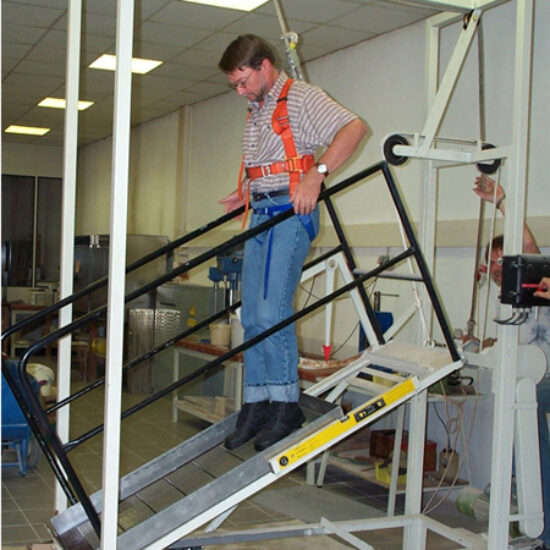- 1300 730 062
-
Spec Binder
- create a PDF of your selections
Oil/Wet Ramp Test

The Oil-wet Ramp Test (commonly referred to as just the “Ramp test”) provides scores that are widely recognised by most designers from their R – rating results R9, R10 etc. The mechanism of achieving these results however is often poorly understood, as are the limitations of this test method. There are very significant limitations to the ramp test and the creation of designs and specifications using ramp test results alone has lead to many problems for designers, their clients and indeed users and operators of facilities.
An investigation of slip resistance following an accident will almost certainly not involve the ramp test results, but rather will consider on-site pendulum testing. It therefore follows that to design a floor without knowledge of the pendulum results of the floor surface selected is a significant risk.
A large part of recognising the ramp test’s limitations is obvious when the test method is explained. Approximately ½ a sqm of tiles to be tested is placed on a horizontal ramp panel, which is then inclined to the point where the test operator walking on it “slips”. The steepness of the angle of the ramp panel is then measured and given a category rating from R9 to R13.
The following is a brief list of the limitations of the ramp test method:-
- Ramp angle results are simply a made-up number – they bear no correlation to the slope of a surface on which the tile can be used.
- The ramp test is not portable and can only be done in laboratory conditions
- The test shoes are a specific type of heavily profiled shoe and subject to the shoe manufacturers production and availability, which has caused problems over recent times
- Heavily profiled sole shoes may not reflect the footwear of the majority of users for the design application.
- Oil/water mix is the contaminant used on the test pieces, this may not reflect the conditions of the design application (i.e. will oil be present ?)
- A slip incident investigation will almost certainly involve conducting a pendulum test on-site. A ramp result used to make a design selection will carry little weight against a poor pendulum result conducted after a slip.
- There is no wear testing procedure or data bank following wear for the ramp test method
- Virtually all of the latest updates in the Australian Standards refer to pendulum testing methodology
Get in touch with us

SYDNEY DESIGN GALLERY & HEAD OFFICE,
Unit 36, 69 O’Riordan Street,
Alexandria NSW 2015 Australia
Hours:
Monday to Friday
Appointment recommended
Head Office
27-29 Liberty Road, Huntingwood NSW 2148 Australia
Tile Distribution Centre/Materials warehouse
27-29 Liberty Road, Huntingwood NSW 2148 Australia
General Enquiries

MELBOURNE DESIGN GALLERY
108 Gipps Street
(Cnr Gipps & Hoddle Streets)
Collingwood VIC 3066 Australia
Hours:
Monday to Friday
Appointment recommended
General Enquiries
- melbourne@metztiles.com.au
- 1300 730 062
- Direct Line: 0394191599

BRISBANE DESIGN GALLERY
124 Petrie Terrace
Petrie Terrace QLD 4000 Australia
Hours:
Monday to Friday
Appointment recommended
General Enquiries
- brisbane@metztiles.com.au
- 1300 730 062
- Direct Line: 0733673367

PERTH DESIGN GALLERY
993 – 995 Hay Street
Perth WA 6000 Australia
Hours:
Monday to Friday
Appointment recommended
General Enquiries
- perth@metztiles.com.au
- George: 0499 221 193
- Direct Line: 08 9481 2404


